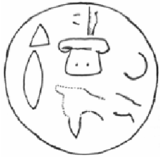Anatolian hieroglyphs
| Anatolian hieroglyphs Luwian Hittite hieroglyphs Hittite hieroglyphs |
|
|---|---|
 |
|
| Type | |
| Direction | Left-to-right |
| ISO 15924 | Hluw, 080 |
|
Unicode alias
|
Anatolian Hieroglyphs |
| Final Accepted Script Proposal | |
Anatolian hieroglyphs are an indigenous logographic script native to central Anatolia, consisting of some 500 signs. They were once commonly known as Hittite hieroglyphs, but the language they encode proved to be Luwian, not Hittite, and the term Luwian hieroglyphs is used in English publications. They are typologically similar to Egyptian hieroglyphs, but do not derive graphically from that script, and they are not known to have played the sacred role of hieroglyphs in Egypt. There is no demonstrable connection to Hittite cuneiform.
Individual Anatolian hieroglyphs are attested from the second and early first millennia BC across Anatolia and into modern Syria. The earliest examples occur on personal seals, but these consist only of names, titles, and auspicious signs, and it is not certain that they represent language. Most actual texts are found as monumental inscriptions in stone, though a few documents have survived on lead strips.
The first inscriptions confirmed as Luwian date to the Late Bronze Age, ca. 14th to 13th centuries BC. After some two centuries of sparse material, the hieroglyphs resume in the Early Iron Age, ca. 10th to 8th centuries BC. In the early 7th century BC, the Luwian hieroglyphic script, by then aged some 700 years, was marginalized by competing alphabetic scripts and fell into oblivion.
While almost all the preserved texts employing Anatolian hieroglyphs are written in the Luwian language, some features of the script suggest its earliest development within a bilingual Hittite-Luwian environment. For example, the sign which has the form of a "taking" or "grasping" hand has the value /ta/, which is precisely the Hittite word ta-/da- "to take," in contrast with the Luwian cognate of the same meaning which is la-. There was occasionally some use of Anatolian hieroglyphs to write foreign material like Hurrian theonyms, or glosses in Urartian (such as ![]() á - ḫá+ra - ku for
á - ḫá+ra - ku for ![]() aqarqi or
aqarqi or ![]() tu - ru - za for
tu - ru - za for ![]() ṭerusi, two units of measurement).
ṭerusi, two units of measurement).
...
Wikipedia
